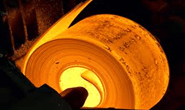SMU Data and Models

SMU Price Momentum Indicator Adjusted to Higher from Neutral
Written by John Packard
November 4, 2013
On Thursday, October 31st Steel Market Update adjusted our Price Momentum Indicator from Neutral to Higher. We now believe domestic flat rolled steel prices will rise over the next 30 to 60 days.
We have already begun reporting prices as rising over the past three weeks. Prices on benchmark hot rolled coil had been bouncing around the $635 to $650 average going back to the second week of July. Prior to the 15th of October when HRC was measured at $655 per ton, we had seven weeks of relative calm with prices averaging $640 per ton and not moving up or down more than $5 per ton in any one week.
Based on conversations with steel mills, end users and service centers/wholesalers, we are finding the combination of low inventories running at approximately 2.1 months based on both MSCI and SMU survey data. Our SMU Apparent Excess/Deficit inventory formula indicated flat rolled steel distributors at the end of September were running a deficit of 382,000 tons. This is down from the prior month’s analysis but still a long way from balanced based on our calculations.
There continue to be issues with supply as mills work through maintenance and U.S. Steel brings back online their Lake Erie Works furnace in Canada. We have a major expansion project at Nucor Berkeley, a reline at ArcelorMittal Cleveland and Severstal has projects at both Dearborn and Columbus. Other mills will be conducting maintenance which has been (or will be) constricting supply over the next two months.
Most of the coating mills – including most of the conversion mills – are very close to selling out their order book for the balance of 2013. Hot rolled lead times are reported to be out into December at most mills (4 weeks plus) and cold rolled lead times are reported to be extended.
As one steel mill executive put it to SMU during a conversation earlier this week, “The dip has come and gone and most never even knew it happened.”
One of the keys behind our decision to raise our Indicator to Higher was what we were hearing out of our scrap sources. Mike Marley of Metal Prices reported earlier this week of some early November scrap sales being concluded at plus $20 per gross ton. The scrap buyers and sellers are expecting at least a $20 per gross ton increase when November price negotiations are concluded sometime next week and we have heard there could be pockets where the numbers approach $30 to $40 per gross ton. If we see increases at the $30 to $40 per ton level it is our opinion that the domestic mills would attempt to increase prices to collect all, or at least a portion, of the higher scrap prices.
The domestic mills have taken a very firm stand regarding contract negotiations. So much so that it is our opinion many of the contracts will either become quarterly fixed price contracts or will float with the spot market. This may continue until a time when manufacturing companies feel comfortable with the prices being quoted. Many buyers have been under the impression that we would see lower prices as we reach the end of the calendar year or early into 2014. They have been holding back purchases and will have no choice but to buy product over the next 30 to 60 days.
“[They] Can’t outwait this market, is what the mill executive quoted above told us. “I think the realization is going to hit in the next week or two. If scrap jumps on top of the buyers scrambling to cover orders then it is going to get quite wild.”
A second mill executive told us his coating lines were basically done for the balance of the year. “So far no deals, no contracts concluded for next year,” is what we were told. “We will probably offer some rebates at much reduced rates and we will walk away from some of the contract business we had this year.”
SMU also recognizes the change in management at Severstal and U.S. Steel. It is apparent the new management is in place to change the return on investment for the shareholders or owners of the mills.
Then we have the ThyssenKrupp Steel Americas sale and the rumor mill. We should not discount the psychology of the rumors being pushed by the domestic mills regarding a change in ownership at TK USA. There has not been an announcement and any change that does occur would take a number of months to complete. Even so, the threat of TK USA being purchased by an existing domestic mill has the rumor mill saying prices would tighten if/when it happens.
On the world stage, China is doing much better than most had projected and iron ore prices have remained much higher than anticipated. Originally, many analysts were forecasting iron ore to drop below $100 per dry metric ton (dmt) by the fourth quarter 2013. This has not happened with benchmark 63% Fe fines being reported at $135.3/dmt by The Steel Index earlier today. Bank of American Merrill Lynch Research iron ore analysts have raised their forecast for ore by $10/dmt within the last 24 hours.
Andre Marshall, CEO of Crunch Risk, LLC in his Thursday evening report on Hot Rolled Futures (SMU 10/31) in our Executive edition of Steel Market Update warned of commodity turbulence in the months ahead.
This is not to say that we should not be concerned with the impact of international steel as the rest of the world steel is in over-supply and looking for a place to send their excess capacity. It is our opinion as we move into 2014 foreign steel and foreign steel prices may well end the run of higher domestic prices.
SMU believes 2014 will be a volatile year for flat rolled steel prices. But, for now we see prices as rising over the next 30 days.

John Packard
Read more from John PackardLatest in SMU Data and Models

Apparent steel supply remained high in May
The volume of finished steel entering the US market remained elevated in May, in line with April figures, according to SMU’s analysis of Department of Commerce and American Iron and Steel Institute (AISI) data

June service center shipments and inventories report
Flat rolled = 55.8 shipping days of supply Plate = 59.4 shipping days of supply Flat rolled US service centers’ flat-rolled steel supply edged down in June with a modest boost to shipments month on month (m/m). At the end of June, US service centers carried 55.8 shipping days of flat roll supply, down from […]

SMU Scrap Survey: Sentiment Indices rise
Both current and future scrap sentiment jumped this month, though survey participants reported responses before key trade news was announced.

SMU Survey: Sentiment splits, buyers have better view of future than the present
SMU’s Steel Buyers’ Sentiment Indices moved in opposite directions this week. After rebounding from a near five-year low in late June, Current Sentiment slipped again. At the same time, Future Sentiment climbed to a four-month high. Both indices continue to show optimism among buyers about their company’s chances for success, but suggest there is less confidence in that optimism than earlier in the year.

SMU scrap market survey results now available
SMU’s ferrous scrap market survey results are now available on our website to all premium members. After logging in at steelmarketupdate.com, visit the pricing and analysis tab and look under the “survey results” section for “ferrous scrap survey” results. Past scrap survey results are also available under that selection. If you need help accessing the survey results […]
